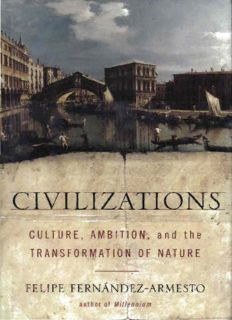Table Of ContentU.S. $35.00
I
n Civilizations, Felipe Ferngndez-Armesto once
again proves himself a brilliantly original historian,
capable of large-minded and comprehensive
works; here he redefines the subject that has fascinated
historians from Thucydides to Gibbon to Spengler to
Fernand Braudel: the nature of civilization.
To Fernindez-Armesto, a civilization is "civilized in
direct proportion to its distance, its difference from the
. . .
unmodified natural environment" by its taming and
warping of climate, geography, and ecology. The same
impersonal forces that put an ocean between Africa and
India, a river delta in Mesopotamia, or a 2,000-mile-long
mountain range in South America have created the
mold from which humanity has fashioned its own wildly
differing cultures. In a grand tradition that is certain to
evoke comparisons to the great historical taxonomies,
each chapter of Civilizations connects the world of the
ecologist and geographer to a panorama of cultural his-
tory. In Civilizations, the medieval poem Sir Gawain and
the Green Knight is not merely a Christian allegory, but
a testament to the thousand-year-long deforestation of
the trees that once covered 90 percent of the European
mainland. The Indian Ocean has served as the mld's
greatest trading highway for millennia not merely
because of cultural imperatives, but because the regular
monsoon winds blow one way in the summer and the
other in the winter.
In the words of the author, "Unlike previous
attempts to write the comparative history of civilizations,
it is arranged environment by environment, rather than
period by period, or society by society." Thus, seventeen
distinct habitats serve as jumping-off points for a series
of brilliant set-piece comparisons; thus, tundra civiliza-
tions from Ice Age Europe are linked with the Inuit of
the Pacific Northwest; and the Mississippi mound-
builders and the deforesters of eleventh-century Europe
are both understood as civilizations built on woodlands.
Here, of course, are the familiar riverine civilizations of
Mesopotamia and China, of the lndus and the Nile; but
also highland civilizations from the Inca to New Guinea;
island cultures from Minoan Crete to Polynesia to
Renaissance Venice; maritime civilizations of the Indian
Ocean and South China Sea . . . even the Bushmen of
Southern Africa are seen through a lens provided by the
desert civilizations of Chaco Canyon.
More, here are fascinating stories, brilliantly told-
of the voyages of Chinese admiral Chen Ho and
Portuguese commodore Vasco da Gama, of the Great
Khan and the Great .Zimbabwe. Here are Hesiod's tract
on maritime trade in the early Aegean and the most
up-to-date genetics of seed crops. Erudite, wide-ranging,
a work of dazzling scholarship written with extraordinary
flair, Civilizations is a remarkable achievement . . . a tour
de force by a brilliant scholar.
FELIPE FERN~NDEZ-ARMESTO
is a Professorial Fellow of Queen
Mary, University of London, and a
member of the Modern History Faculty
at Oxford University. He is the author of twelve books,
including Millennium and Truth: A Histow
I
Visit us onllnc at www.simonsays.crm
IACKET DESIGN BY ERICSUENTECILLA
IACKET ILLUSTRATION: CANALETTO. VENICE. BRIDGE OF ME RIALTO1
COURTESY OF THE GRANGER COLLECTION
AUTHOR PHOTOGRAPH BY BARRY BURNS
PRINTED IN THE U S A
COPYRIGHT 0 2001 SIMON 8 ICHUSTER INC
DISTRIBUTED BY SIMON B SCHUSTER INC.
Truth: A History
Religion
The Times Illustrated History of Europe
Millennium
The Spanish Armada
Columbus
Barcelona
Columbus on Himself
Edward Gibbon's Atlas of the World
Before Columbus
The Canary Islands after the Conquest
Reformation (with Derek Wilson)
Canarias e Inglaterra a traves de la historia
(with Antonio Be'thencourt Massieu and others)
The Times Atlas of European History
(with Mark Almond, \eremy Black, Rosamond McKitterick
and Chrias Scarre)
The Times Guide to the Peoples of Europe (editor)
The Folio Society History of England (editor)
The Global Opportunity (editor)
The European Opportunity (editor)
The Times Atlas of World Exploration (editor)
civil
CULTURE, AMBITION, AND
THE TRANSFORMATION
OF NATURE
THE FREE PRESS
NEW YORK LONDON TORONTO SYDNEY SINGAPORE
THE FREE PRESS
A Division of Simon 6 Schuster, Inc.
1230 Avenue of the Americas
New York, NY 10020
Copyright O 2001 by Felipe Ferncindez-Armesto
AII rights reserved,
including the right of reproduction
in whole or in part in any form.
THEF REEP RESSa nd colophon are
trademarks of Simon 6 Schuster, Inc.
Designed by Edith Fowler
Manufactured in the United States of America
Library of Congress Cataloging-in-PublicationD ata
Femcindez-Armesto, Felipe.
Civilizations :c ulture, ambition, and the transformation of nature l Felipe Ferncindez-Armesto.
p. cm.
Includes bibliographical references (p. ) and index.
I. Civilization-History. 2. Human geography. 3. Human ecology. 4. Nature-
Effect of human beings on. 5. Ambition-History. I. Title.
CB151 .F47 2001
909 -d c21 2001018154
ISBN 0-7432-0248-1
"JapanR evived" (1953) by Edmund Blunden is taken from A Hong Kong House: Poems
195 1-1961 (copyright Edmund Blunden 1962). Reproduced by permission of PFD on be-
half of the Estate of Edmund Blunden.
Extract from the song "Mad Dogs and Englishmen" by Noel Coward reproduced by per-
mission of Methuen Publishing Ltd, London.
Extract from Collected Poems, 1909-1962 by T. S. Eliot reproduced by permission of
Faber and Faber Ltd, London.
Quotations from publications of The Hakluyt Society reproduced by kind permission of
the Council of The Hakluyt Society.
Description:Erudite, wide-ranging, a work of dazzling scholarship written with extraordinary flair, Civilizations redefines the subject that has fascinated historians from Thucydides to Gibbon to Spengler to Fernand Braudel: the nature of civilization.To the author, Oxford historian Felipe Fernández-Armesto, a

